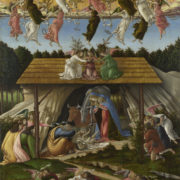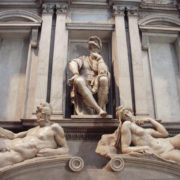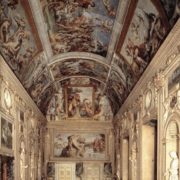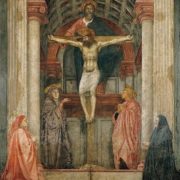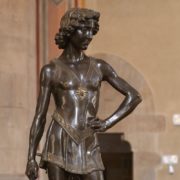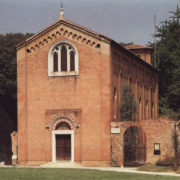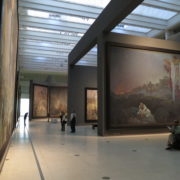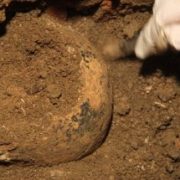Paradise Lost?
In October, the stunning announcement was made that three panels from Lorenzo Ghiberti’s bronze doors for the East side of the Baptistery in Florence, Italy, will make an unprecedented journey to the United States in 2007.
The planned three-city tour will begin at the High Museum in Atlanta, where an exhibition is scheduled from 28 April to 15 July, The Gates of Paradise: Lorenzo Ghiberti’s Renaissance Masterpiece.
The exhibition, which has been in the works for a number of years, was organized by the High Museum in partnership with the Opera di Santa Maria del Fiore and the Opificio delle Pietre Dure, which conducted the restoration of the doors. After the High Museum, they will travel to The Art Institute of Chicago and the Metropolitan Museum of Art in New York. The panels selected for shipment are all from the left door, illustrating the Biblical stories of Adam and Eve, Jacob and Esau, and David and Goliath. They will be accompanied by four other figures from the left door frame, two standing figures and two busts.
The 3-ton doors, of which replicas have been placed in their original location since 1990, have undergone an extensive restoration campaign, one panel at a time, that has lasted for more than a quarter of a century. The last of these panels, depicting scenes of Noah, has only recently been completed, and was unveiled on November 3rd in Florence, one day before the 60th anniversary of the flood that was blamed for much of the damage to the doors. Even though the restoration project was not the result of the planned exhibitions, the issue of restoration will be a primary one for the 2007 show. In preparation for this, the High Museum instituted a workshop in Florence to study the creation and treatment of the doors. In addition, of the two standing figures and two busts to be shipped with the panels, one of each will be shown in its pre-restored state as a means of demonstrating the effects of the modern cleaning campaign.
Increasingly, art restoration has been tightly linked with these blockbuster exhibitions, and hence with tourism. The High Museum in the past has used the incentive of restoring a work of art as a means of bargaining for more and more high-profile loans. In 2003, the High funded the restoration of Andrea del Verrocchio’s bronze David, with its same interest in the scientific and technical aspects of the cleaning, in return for its loan to the Atlanta museum for a nearly three-month period in late 2003 to 2004. In fact, the exhibition, which was the first time in its over 500-year history that the statue left Italy, was entitled Verrocchio’s David Restored, emphasizing the notion of discovery via new technology over the object itself. This idea that something must be made “new” in order to entice visitors to the blockbuster show is something that underlies the Ghiberti exhibition as well.
It is true that the High Museum did not assist in the financing of the Gates of Paradise restoration, which was funded by the Italian government with assistance of the American group Friends of Florence (who pay for the restoration of high-profile objects, including the recent controversial cleaning of Michelangelo’s David). Nonetheless, financial support of a future restoration project was promised in return for the loan: the High Museum has agreed to fund the cleaning of the Silver Altar of the Baptistery, now housed in the Museo dell’Opera del Duomo.
There seems to be an awareness of the risk of sending these irreplaceable objects on a three-city trans-Atlantic tour, as well as of the fragility of their state. Even after restoration, the doors will never be returned to their original outdoor setting on the eastern face of the Florentine Baptistery. Nor will they ever travel again, according to Italian officials. Instead, they will be placed in the Museo dell’Opera del Duomo in hermetically sealed, oxygen-free cases, in order to protect them as fully as possible from environmental threats. Special cases are being designed for their transport, and the panels will travel separately.
Regardless of any attempts to ensure the safety of those pieces of Ghiberti’s doors, there are risks involved in the shipment of any art object, ranging from damage caused by transportation, the threat of catastrophic events such as airplane crashes, to theft. The question is, does the financial benefit of the partnership between the High Museum and the Opera of Santa Maria del Fiore in Florence warrant the assumption of those risks, especially in the case of an object so precious that the decision has been made never to take those chances before, or again in the future? The Director of the High Museum referred to Ghiberti’s doors as a “major pilgrimage,” which is undoubtedly true. But it is up to the pilgrim to make the journey.


